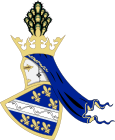Kingdom of Bosnia Bosansko kraljevstvo Босанско краљевство | |||||||||
|---|---|---|---|---|---|---|---|---|---|
| 1377–1463 | |||||||||
 Medieval Bosnian State Expansion | |||||||||
| Capital | 44°08′13″N 18°14′16″E / 44.13694°N 18.23778°E | ||||||||
| Religion | CatholicismBosnian Church (official)[1]Eastern Orthodoxy | ||||||||
| Demonym(s) | Bosnian | ||||||||
| Government | Feudal monarchy | ||||||||
| King | |||||||||
• 1377–1391 | Tvrtko I (first) | ||||||||
• 1461–1463 | Stephen Tomašević (last) | ||||||||
| Historical era | Middle Ages | ||||||||
• Coronation of Tvrtko I | 26 October 1377 | ||||||||
| 5 June 1463 | |||||||||
| Currency | Bosnian Golden Coin | ||||||||
| |||||||||
The Kingdom of Bosnia (Serbo-Croatian: Kraljevina Bosna / Краљевина Босна), or Bosnian Kingdom (Bosansko kraljevstvo / Босанско краљевство), was a medieval kingdom that lasted for nearly a century, from 1377 to 1463, and evolved out of the Banate of Bosnia, which itself lasted since at least 1154.
Although Hungarian kings viewed Bosnia as under their sovereignty during this time, Bosnian sovereignty and independence in conducting its affairs is nevertheless undeniable.[citation needed]
King Tvrtko I (r. 1353–91) acquired portions of western Serbia and most of the Adriatic coast south of the Neretva River. During the late part of his reign, Bosnia became one of the strongest states in the Balkan Peninsula. However, feudal fragmentation remained important in Bosnia and the Bosnian nobility held significant power, exercising it at the Stanak meetings where members deliberated on matters such as election of the new king or queen and coronations, foreign policy, sale or cession of territory, contracting and signing treaties with neighboring countries, and military issues.
The Ottoman Empire annexed portions of eastern Bosnia in the 1440s and 1450s and went on to conquer Hum, by then renamed to Herzegovina, with the last fortress, Novi, falling in December 1481. Stephen Tomašević, the last king of Bosnia, was captured by the Ottomans and killed in 1463.
The overwhelming majority of the population was rural, with few significant urban centers. Among the more notable towns were Doboj, Jajce, Srebrenik, Srebrenica, Tešanj, and Podvisoki. Mining, especially for silver, was a major source of income for Bosnian kings.
- ^ Bell, Imogen (2002). Central and South-Eastern Europe 2003. Psychology Press. p. 100. ISBN 9781857431360.

